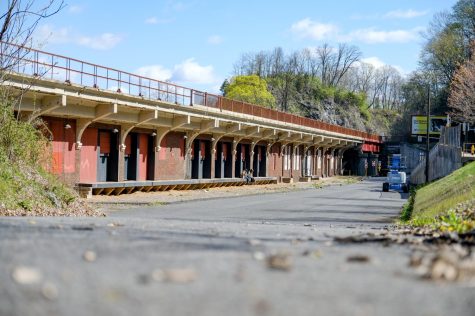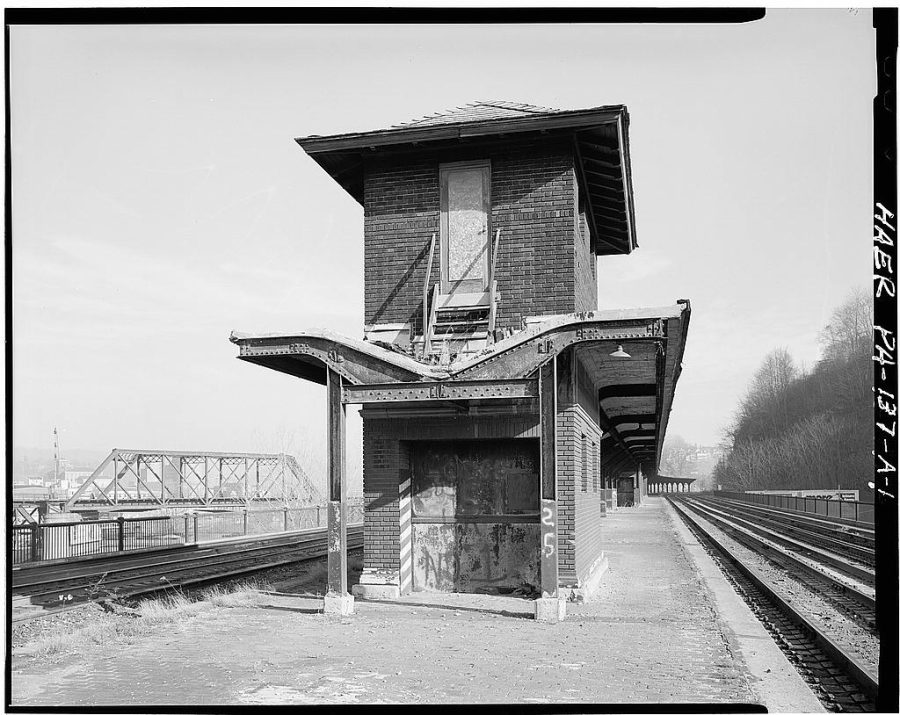Buses and cars are generally thought to be the only forms of transportation available to Lafayette students in Easton. But for a good portion of the 20th century, another reliable manner of going to and from the city existed: the passenger rail.
A reminder of the rail sits close to the city in the form of an abandoned freight and passenger station across the Lehigh River along W. Canal Street.
Rail transport served as a key part of Easton for a century. According to library archives of the Northampton County Historical & Genealogical Society (NCHGS), a group dedicated to preserving the city’s local history in the Sigal Museum in downtown Easton, the Lehigh Valley Railroad was founded on January 7, 1853, with passenger service beginning in 1855.
Easton would soon become the hub for numerous rail lines. According to an article by the Easton Express from June 12, 1937, three notable rail companies stopped at Easton’s rail station: Lehigh Valley, D.L. & W and New Jersey Central. This new attention would ultimately turn Easton from an agricultural town into a key industrial center.
“Iron foundries, rolling mills, and steel plants sought Easton when this new era dawned for the abundant nearby iron ore deposits and rich beds of limestone, together with the coal sources opened up, made an ideal manufacturing site,” the article read. “Other industries followed the transportation lines, and by the end of the nineteenth century, Easton had become an industrial center of importance.”
Thomas Lannon, director of Lafayette College’s Special Collections and Archives, elaborated specifically on the Lehigh Valley Railroad and their station in Easton. He discussed the station, called 3rd and Canal only when utilized for passengers, and its use on the D&LV Railroad for both cargo and passengers.
“The railroads developed over the 19th century when coal was used for energy,” Lannon wrote. “The Lehigh Valley Railroad was built for coal freight, [carrying] anthracite (hard coal) from the Pennsylvanian fields to Eastern Markets (New York City/New Jersey) and into the Great Lakes Region.”

In regard to Easton’s use for passenger transportation, Lannon discussed how the train service, specifically called the “Black Diamond,” was used to transport people only after being made to export and import freight, with cargo transport being the more frequent use of the line through the Lehigh Valley. The NCHGS archives indicated that Easton was located in the middle of the Black Diamond’s passenger trips between New York City and Buffalo, which would run five times per day. Trains also ran long-distance runs from New York to Chicago.
However, Lannon explained that the rail line ran into a myriad of problems that would ultimately lead to its downfall, along with the closure of Easton’s train station.
“The Lehigh Valley Railroad abandoned its last passenger trains around 1961,” Lannon wrote. “The station [in Easton] was abandoned after the decline and eventual demise of passenger train service (automobile industry won the day).”
Freight service, on the other hand, closed in the 1970s due to the decline in demand for coal. According to the NCHGS archives, the station’s canopies and platforms were dismantled on July 24, 1985. Lannon wrote that while it has been considered a possible location for a park, the fact that it is not located on public land means its future is ultimately uncertain.
Currently, the train station in Easton sits abandoned next to the Lehigh River, having been blighted since its closure, according to Lannon. However, with Amtrak having recently proposed restoration of rail service in the Lehigh Valley, with one of the planned stations being located in Easton, the abandoned train station may not be the last that this city has seen of rail transport.





































































































Richard Fields • Dec 1, 2022 at 3:57 pm
Dear Gilad,
As a former resident of Easton and a former employee of the Lehigh Valley Railroad, I read with considerable interest your piece on Easton’s LVRR station and its trains in the April 22, 2022 edition of The Lafayette. I would like to offer several corrections.
The Delaware Lackawanna & Western Railroad never used the LVRR Easton station. Their passenger trains called at the joint Jersey Central/Lackawanna station on South Main Street in Phillipsburg, which still stands. It’s a handsome brick building with a pagoda-like roof and it’s well worth a visit for those with an eye for architecture.
The Black Diamond was not a service; it was the name of the Valley’s flagship passenger train. It operated on a daytime schedule between New York and Buffalo, beginning in 1896 and finally bowing out in May 1959. It was quite the train in its day, carrying parlor cars, a full diner, an observation car, and connecting Pullman sleepers to and from Chicago.
The LVRR did not run trains between New York and Chicago, extending only as far west as Buffalo. Several of its trains did, however, carry through Pullman sleeping cars which the Valley handed off to connecting railroads in Buffalo, which then carried them to Chicago on their trains. The through Pullmans operated during the 1920’s and were largely gone from the timetables by the ’40’s. The LV ran a through overnight train between NYC and Toronto, the Maple Leaf, that lasted until the very end of its long-haul passenger service on February 4, 1961.
The Lehigh Valley’s freight service continued until April 1976, at which time the Valley and several other bankrupt railroads were conveyed into Conrail, the government-sponsored railroad that the Feds created to fix the dire Northeastern railroad situation of that era. The station canopy did come down in July 1985, but the platform from which generations of Eastonians and Lafayette students boarded and detrained from such trains as the Asa Packer, the John Wilkes, and the Black Diamond is extant, if in rough condition. The remaining tracks atop the station are busy with the daily passage of frequent freight trains of owner Norfolk Southern. The former LVRR between Allentown and Newark is now NS’s conduit into the NYC metro area; NS is one of the country’s four major freight railroads. Note: the station was never known as the 3rd and Canal; locals referred to it simply as the Lehigh Valley station.
After the LV threw in the towel on passenger service, Easton still had passenger trains to the NYC area provided by the Jersey Central railroad. The CNJ had a lovely brick Victorian station at the foot of South Fourth Street, complete with a round “witch cap” tower. The Central finally pulled the plug on its Lehigh Valley area passenger trains in April 1967. The station, sad to say, was abandoned and eventually torched by vandals in 1975.
Rail passenger service returned to the area from 1974 until 1982 when the state of New Jersey extended three weekday CNJ round trips to Phillipsburg from Hampton. The trains ran between P’burg and Newark and never developed sufficient ridership to justify their continued operation. New Jersey Transit lost little time in cutting them when it took over operations. Major funding for Amtrak was included in the Infrastructure package passed earlier this year and it will be interesting to see if passenger trains return to the Lehigh Valley area.
As I mentioned, I worked for the Lehigh Valley Railroad as a station agent and tower operator (kind of like an air traffic controller, but with trains instead of planes). I hired out in March 1974 and was there until the Valley was swallowed up by Conrail on April 1,1976, toiling away in various stations and towers in New Jersey and the Lehigh Valley area. I also did a stint as a reporter on The Lafayette during my junior year at the College.
Best regards,
Richard Fields, ’73.